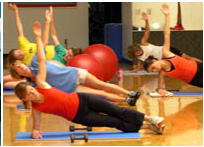First off, since this is my first E-mail since I've been back, Happy New Year! Second, I do realize that it is Thursday but I am running a little behind this week as my Spring semester starts (OK, and I was at the basketball game last night...go HEELS!). I really wanted to talk about facing some common workout fears as you all start on your new fitness resolutions (you did get started, right?). Some of these are adapted from this month's issue of "Health" magazine.
Fear # 1 - I won't keep up with the already "in-shape"students in a group fitness class Don't fret: You most likely are not the only "newbie" in the class and some of those "lean" students you fear may not even be in good shape. Get to the class a little early and let the instructor know you are new and not sure what to expect. She/He can give you a quick run down on the basics. The instructor may also be able to point you to another new student or to a location in the classroom where you can easily observe but may not be as easily seen by other students, which may leave you less intimidated. If you are really nervous about trying a new class for the first time such as say
pilates, you could try it out in the privacy of your home first to get acquainted with some of the moves and/or terminology. Try an exercise video, an on line Internet class, or a TV channel such as FIT-TV on demand.
FYI- Look out for
Cardio Capoeira on Wen. from 6:30-7:30 with Shoshanna at the
SRC. This is an upbeat energizing Brazilian from of martial arts modified to look like a dance.
Fear # 2 - I don't want to join a gym for a year and end up wasting my money because I don't like it.Don't fret - Take a tour and find out information about the gym before you join. Most gyms will give you at least a free preview day before you have to sign a contract. Try joining with a friend or relative so you all can go together. Or, sign-up for a group class or activity that you can chat with other people in such as aqua aerobics or a walking group, so you can quickly meet people and get into a regular work-out schedule together.
FYI -
UNC campus recreation allows eligible employees to sign-up for a one week trial membership. See
http://www.campusrec.unc.edu/heels.html for more information.
Fear # 3 - My schedule is too crazy and I won't be able to find the time to work out. Don't fret - Physical activity does not have to be all or nothing. Try to find 10-15 minute blocks of time a few times a day to do some sit-ups, go for a walk, or lift some hand weights. Don't underestimate the role of spontaneous activity either. Wear a pedometer and take the stairs or park at the back of the parking lot. You may be surprised how these little efforts can quickly add up to the goal of 10,000 steps a day.
FYI -
UNC's Walk for Wellness campaign is still going strong. Check out
http://www.campusrec.unc.edu/heels.html#walk to learn how to sign up with a team or start your own group.
Fear # 4 - I don't know how to start Don't fret - If your not comfortable starting at a gym, get a pair of hand weights, resistance bands, or yoga ball and start working out at home with some simple exercises such as sit-ups, push-ups, bicep curls,
tricep dips, and shoulder presses. Also, get outside and walk, gradually adding in 30 sec-1 min. jogging bursts while you walk. Or, join a walking group at work, a moms and strollers group such as Stroller Strides, or a physical activity/weight loss program. Many gyms offer personal training or a fitness consultation, which will help you develop a personalized fitness plan.
FYI -
UNC is holding a Biggest Loser Challenge this semester open to faculty and students (faculty will compete separately from students), which will help those wanting to adapt healthy eating habits and an active lifestyle. Check out
http://www.campusrec.unc.edu/events.html#loser for all the details. But act fast, applications are due Jan 19
th.
UNC also offers free fitness assessments and consultations. Sign up by following this link:
http://www.carolinafitness.unc.edu/src/src_files/src_fitness_weight1.htmSo, what are you waiting for? Start facing your fears and commit to a healthy and happy you in 2007!
 This past summer I had the honor of training Lindsey Gredler, a vet technician in Chapel Hill, NC. Lindsey originally sought my services to get back into shape. Like many of us, her workouts had fallen into a slump. She didn't need to lose weight but she wanted to tone up and feel challenged. "Being a former athlete, I was used to having coaches on my heels all the time telling me what I needed to do to improve my overall performance. Without a coach beside me, I realized that I didn't really know what I should be doing to get a really good workout."
This past summer I had the honor of training Lindsey Gredler, a vet technician in Chapel Hill, NC. Lindsey originally sought my services to get back into shape. Like many of us, her workouts had fallen into a slump. She didn't need to lose weight but she wanted to tone up and feel challenged. "Being a former athlete, I was used to having coaches on my heels all the time telling me what I needed to do to improve my overall performance. Without a coach beside me, I realized that I didn't really know what I should be doing to get a really good workout."






















